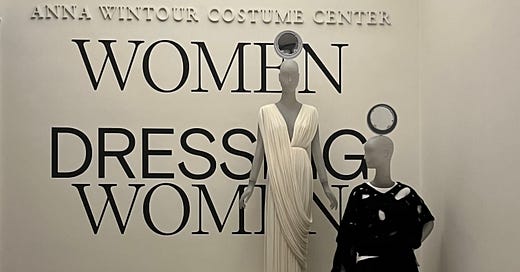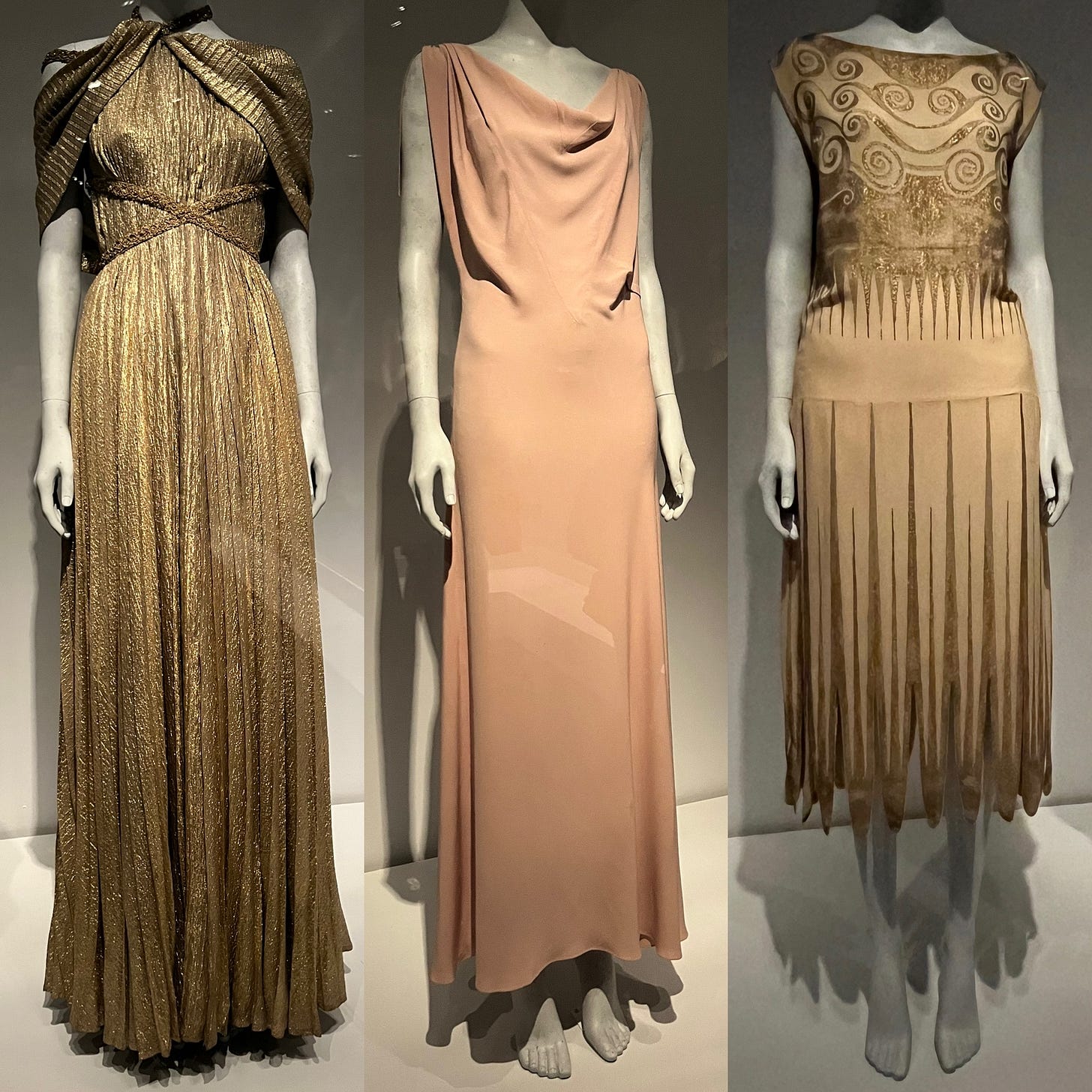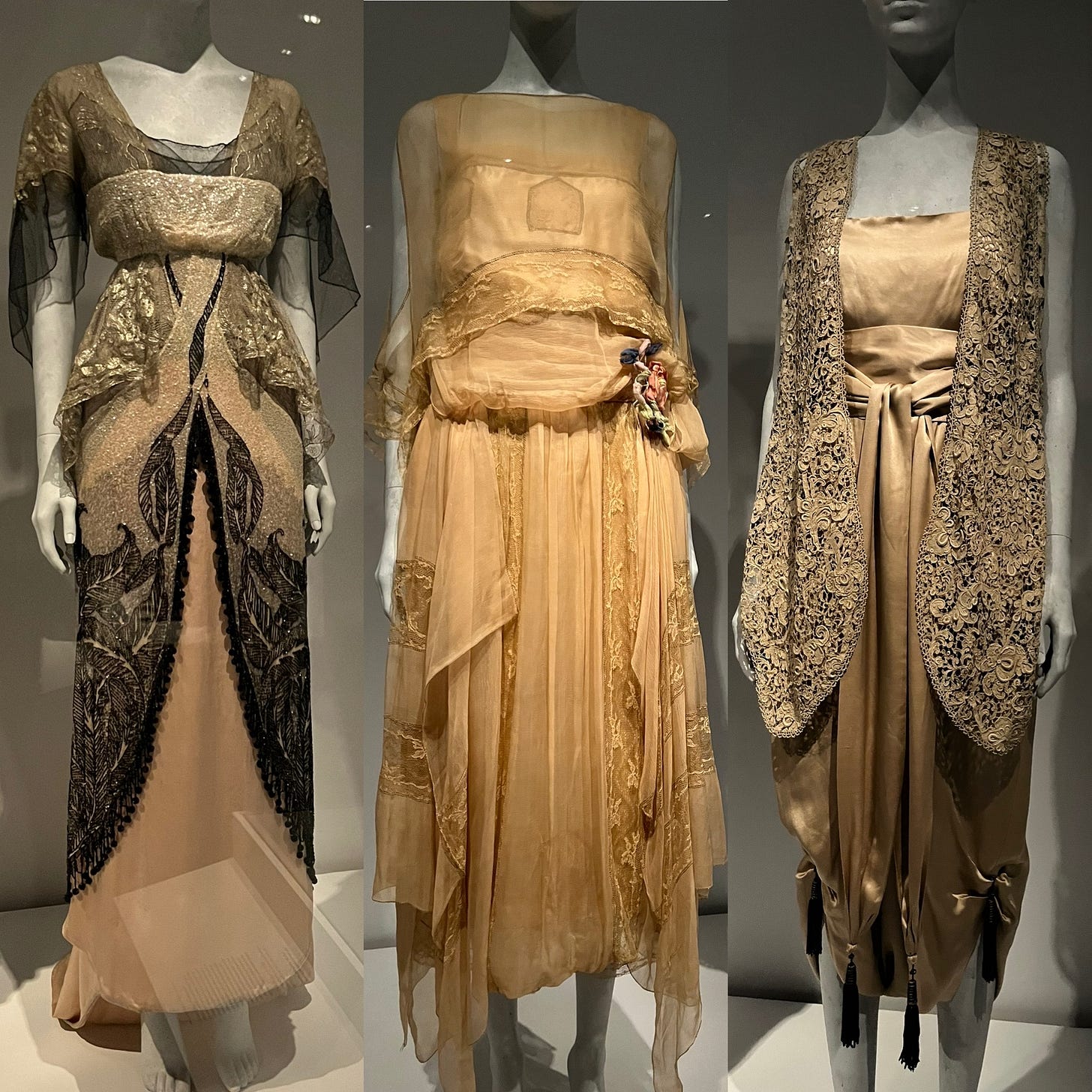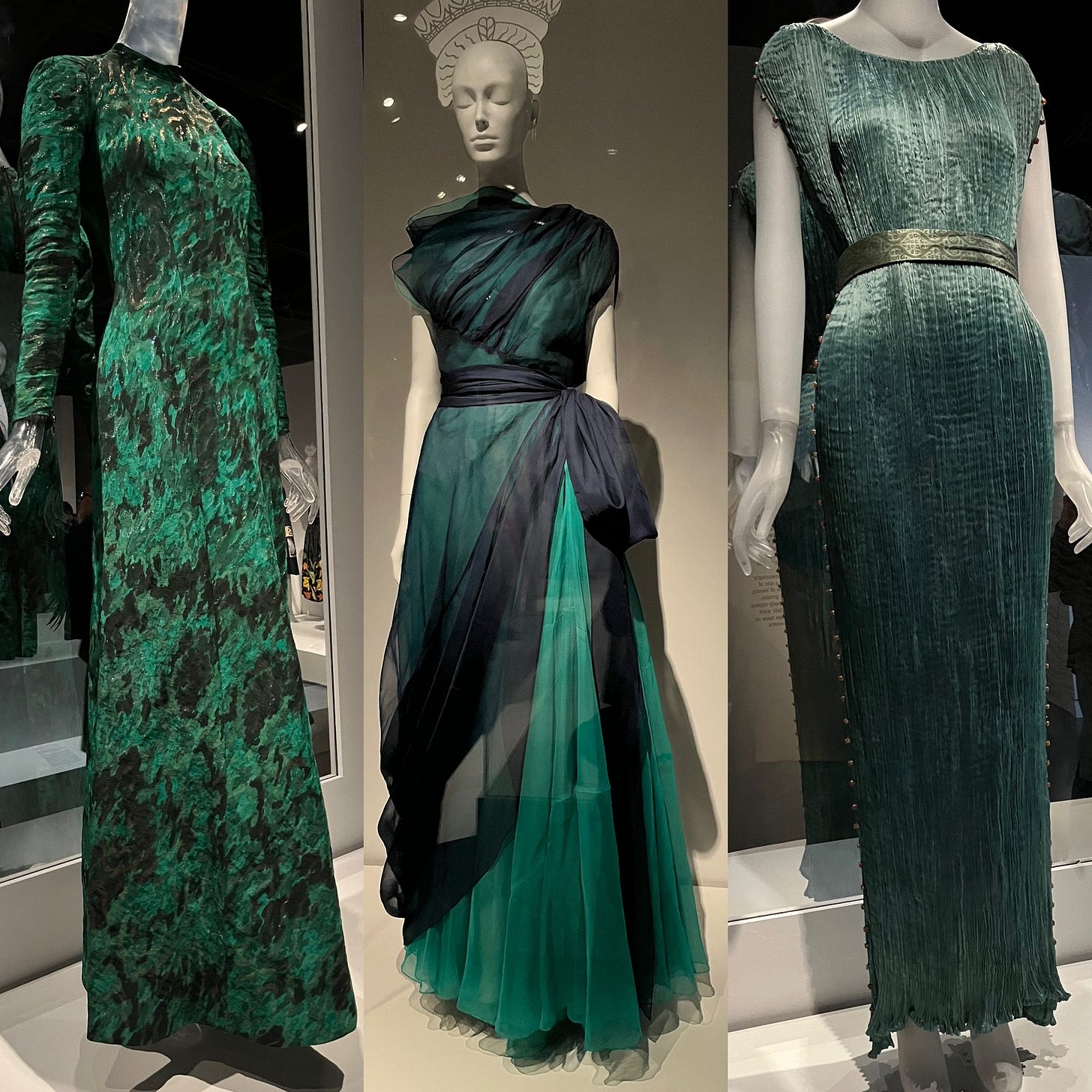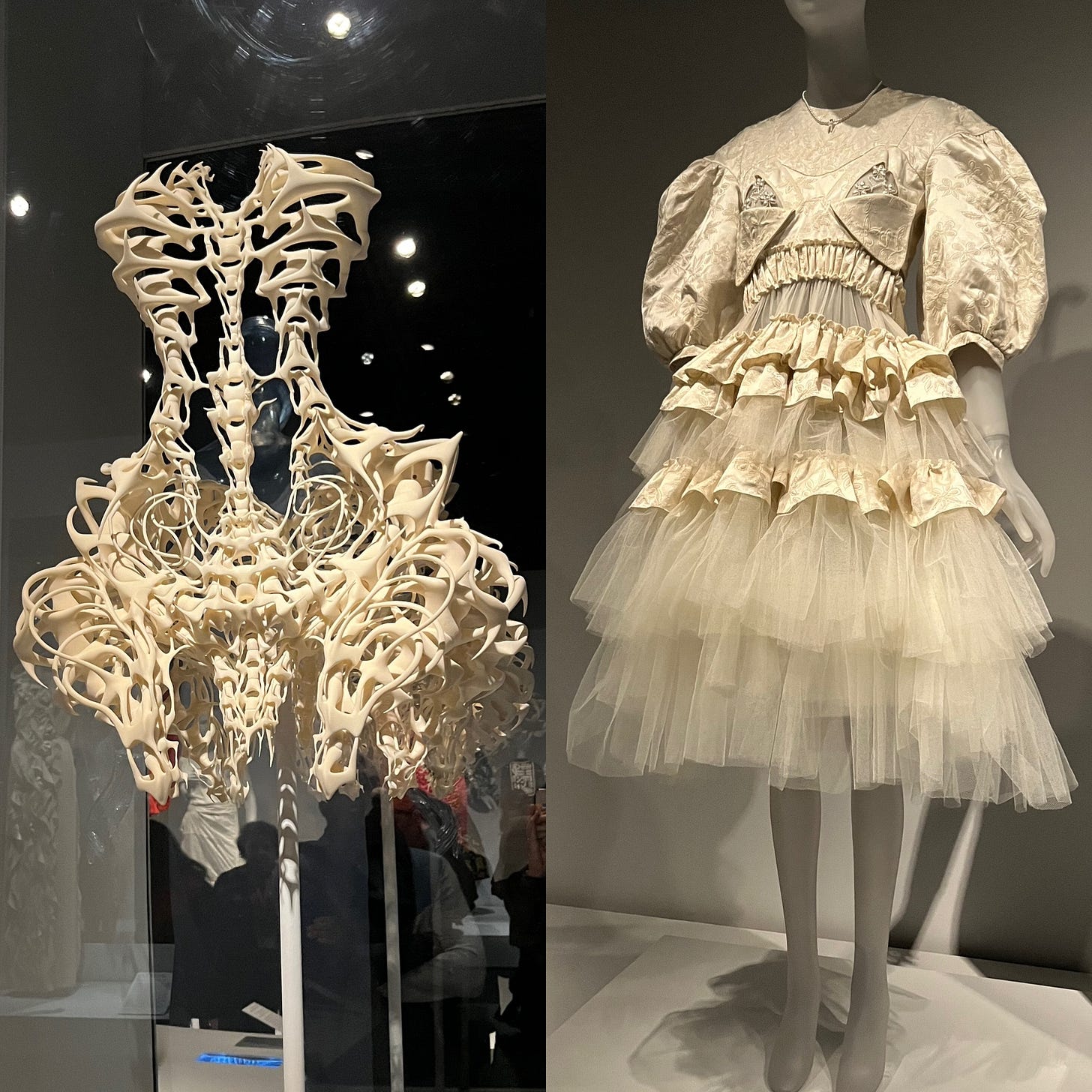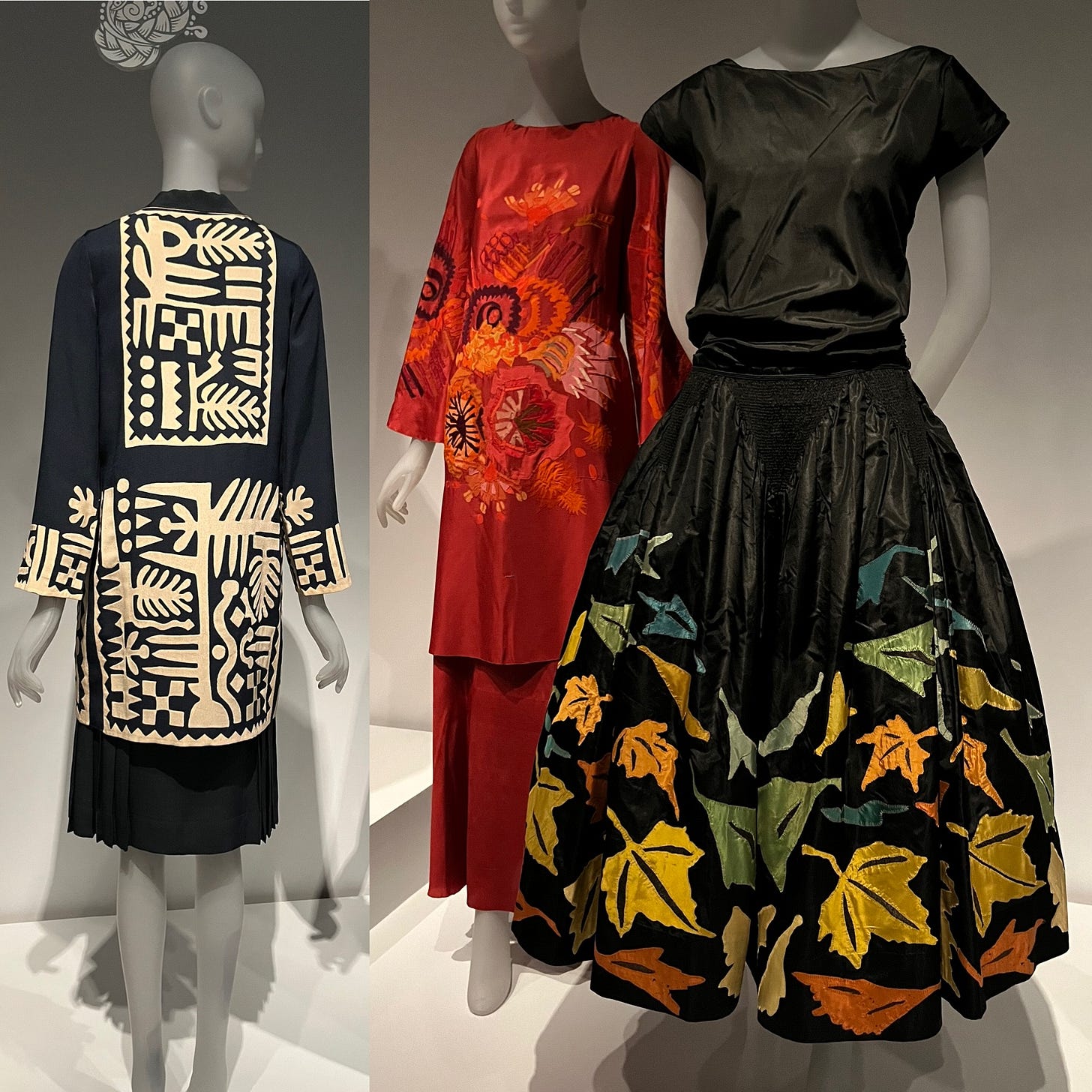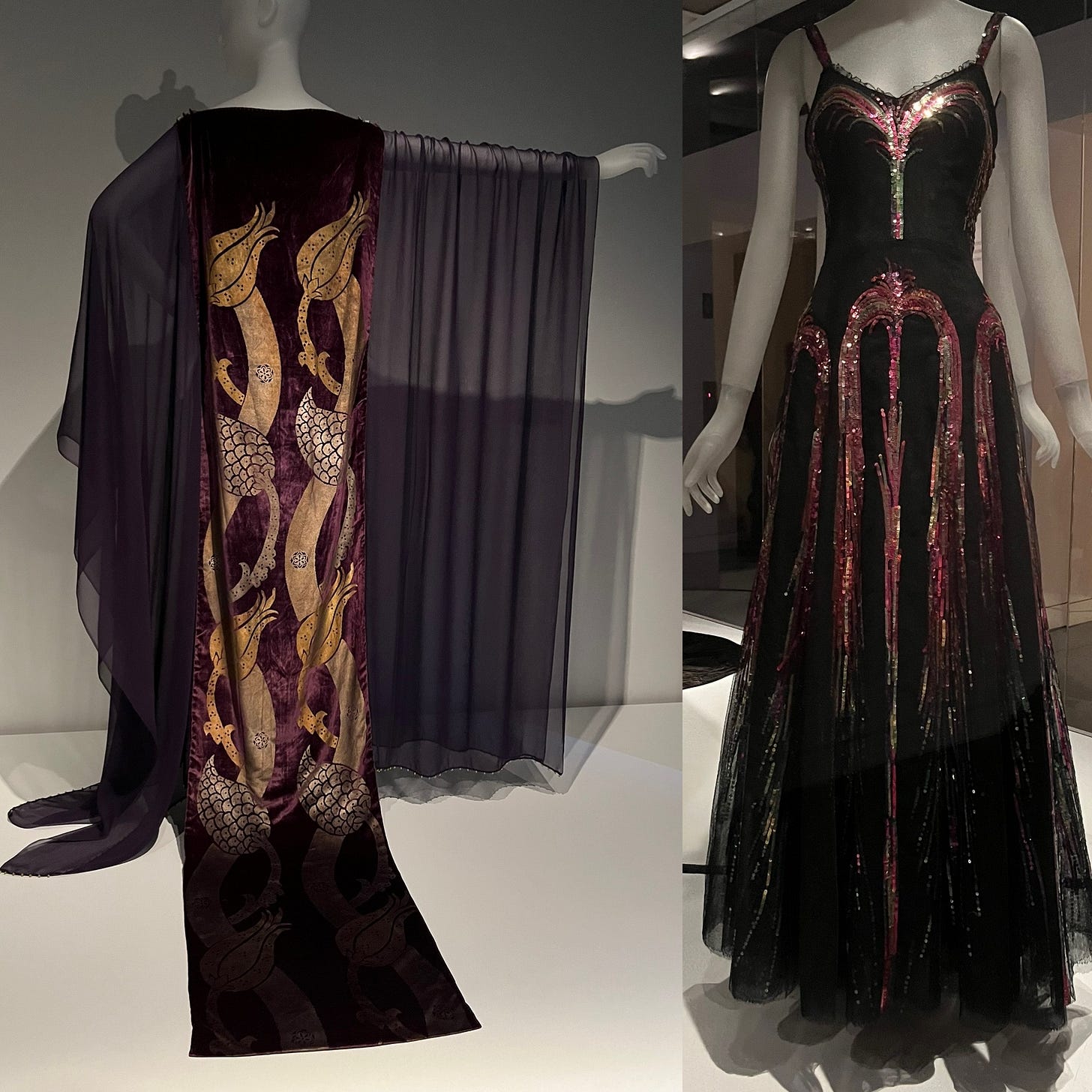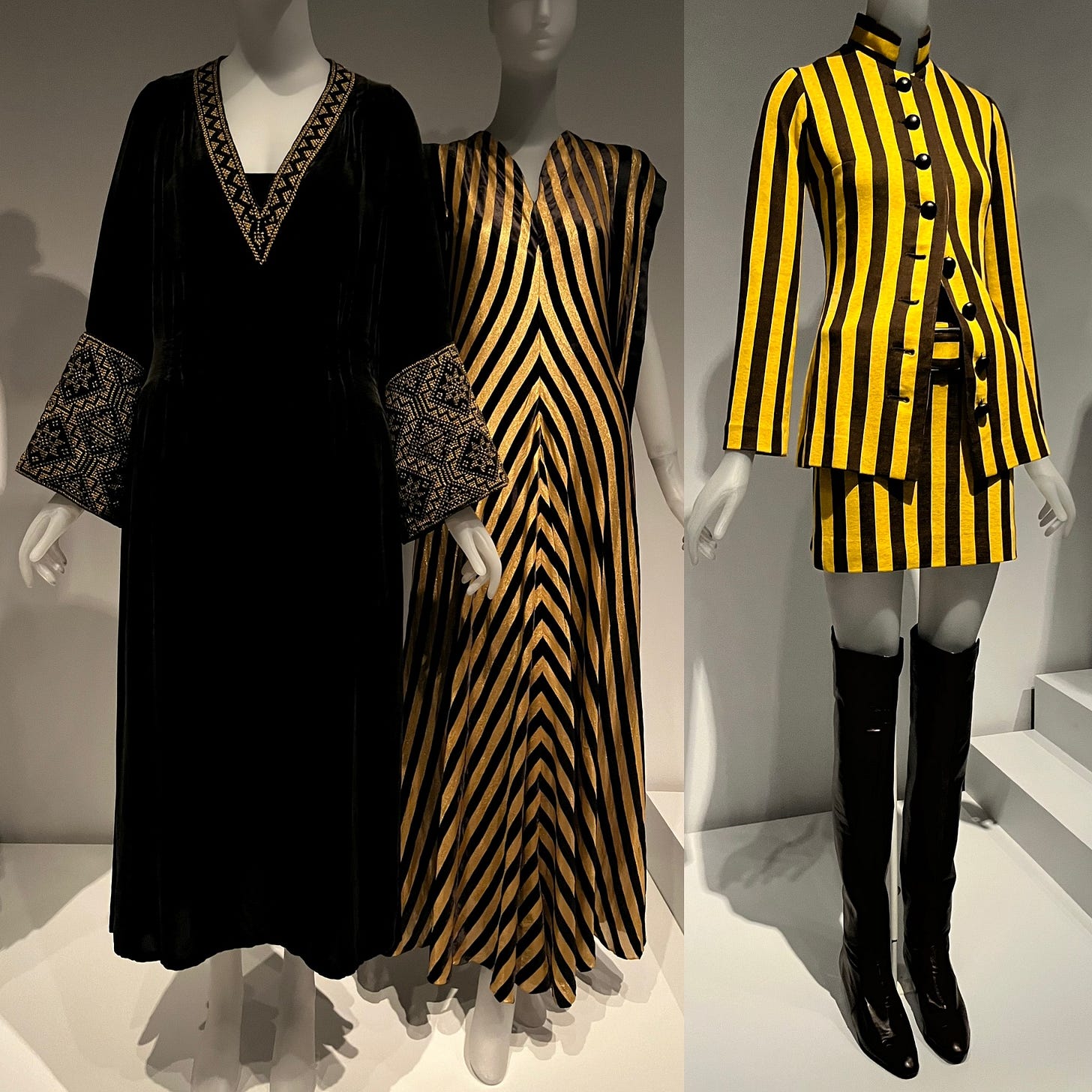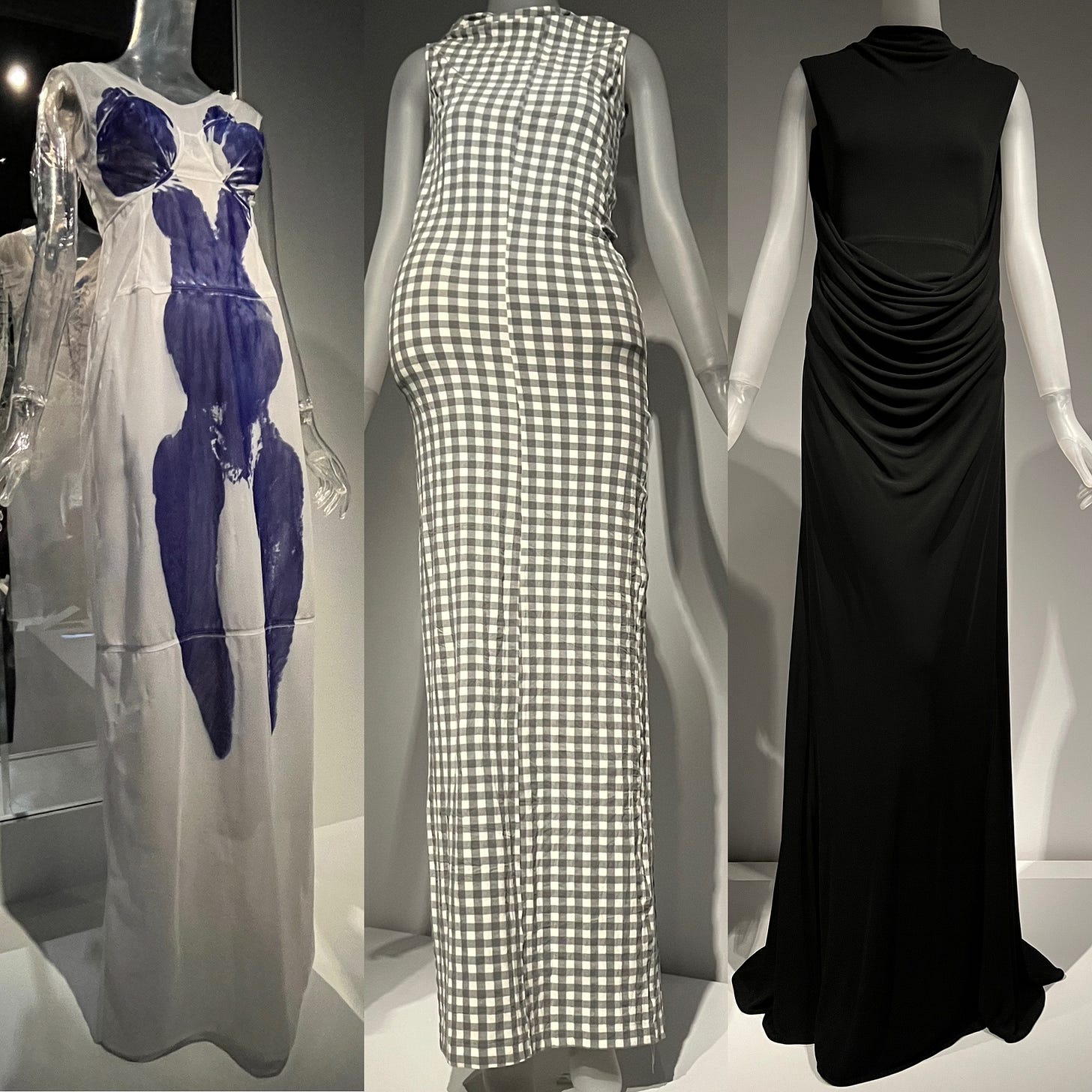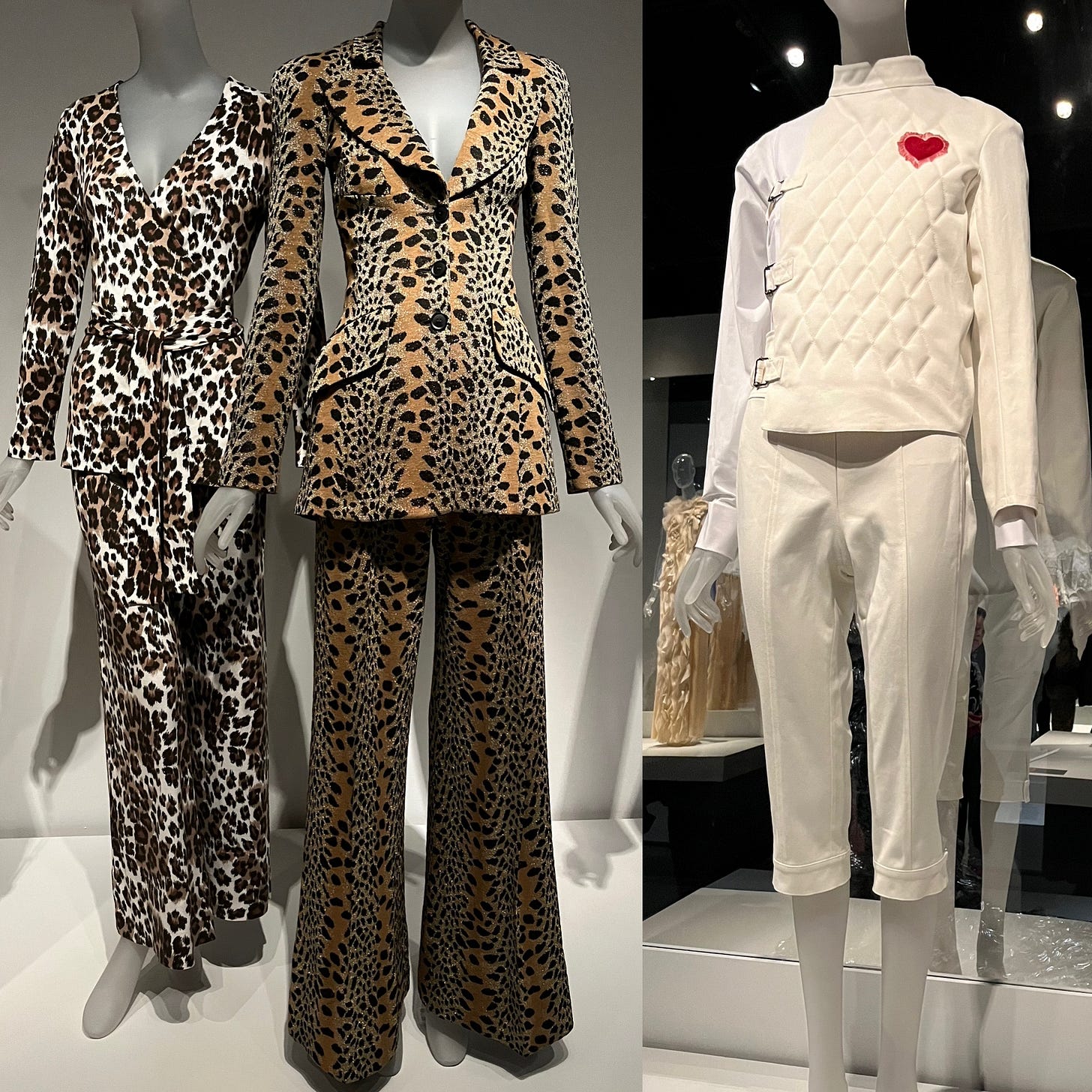Thoughts on “Women Dressing Women” at The Met
A Walk-Through of my Favorite Designs
Because a huge proportion of fashion consumers are women, it’s strange that the industry can be male-centric when it comes to designers. This new exhibit at The Metropolitan Museum of Art, which displays 80 designs created by women for women starting in the early 1900s, provides some much-needed recognition for women’s role in fashion design. The exhibit highlights four main dimensions of womens’ fashion design work: anonymity, visibility, agency, and absence/omission. Though I appreciate The Met’s effort toward organizing these designs by theme, I’m just going to analyze some of my favorite pieces individually, rather than on the thematic level.
These first three dresses were some of my favorites of the whole exhibit. Put altogether, I can imagine these as incredible costumes for some sort of Greek play.
Left - Marcelle Chaumont: This was my favorite of the whole collection. It’s glittery without looking tacky, giving it a magical quality. I love the overlapping fabric on the shoulders and the braided fabric belt.
Middle - Augusta Bernard: This designer spoke of a “dress as a living being that breathed and moved.” The idea that a dress takes on a life of its own, on top of the wearer, might be even more beautifully evident if we could see this dress flowing down a runway.
Right - Madeleine Vionnet: This designer inspired Marcelle Chaumont. The painted design is reminiscent of Greek vase painting. There is no reason why fashion should be limited to dresses that look like dresses or shirts that look like shirts. I love the idea of a dress transforming the body into something else - in this case, the woman walking around might look more like an ancient vase than a woman wearing a dress.
Left - Jeanne Margaine-Lacroix: This dress was meant to emphasize the natural silhouette of a woman without the use of stiff corsets. Her garments helped usher in the idea of draping on the bias, which is a technique that I think often suits the curves of an hourglass female form more naturally than the simple square cuts of the modern day.
Middle - Lucille Duff-Gordon: This piece wasn’t my favorite visually, but the description of the dress mentioned that she had a stage in her couture house that allowed for more movement (music, dance, and theatre) in displaying her works. She featured fashion as an aspect of performance, which resonates with me as someone who has a particular interest in costuming. It’s one thing for a garment to look good when still, or when on a model who is simply walking up and down a runway. It reaches a new level of potential when the garment emphasizes a character, embodies a musical performance, or becomes incorporated in dance.
Right - Marie Collot Soeurs - This look is casually opulent, with its silky texture and intricately constructed vest. The description said that this designer and her three sisters incorporated aspects of Eastern dress into their designs, and I think this look is a good example of how to use non-Western influences in a way that references them without fully appropriating. I especially love the tassels at the end of the waist sash, and the rounded bottom edge of the vest.
Left - Elsa Schiaparelli: I love the dynamic pattern and the variance in shine. It reminds me of how things look when you view them underwater in the dark.
Middle - Madeleine “Mad” Maltezos with Susie Carpentier: This dress features some beautiful tying and layering of fabric, and the asymmetry is masterful.
Right - Designer Unknown: Given the fabric type and technique, this is labeled a “sizeless garment.” There is a swimsuit brand that sells suits like these, and this looks like a much more elegant version of those. I think the elegance comes from the fact that the fabric is shiny. This emphasizes the grooves, rather than making the grooves seem like a purely utilitarian feature added only for the purpose of making the garment “sizeless.”
Left - Iris Van Herpen: In this design, Iris’ intention was making the hidden visible, getting rid of layers of clothing - even layers of skin and muscle. The information under this design said that the vision was “evoking kinesthetic sensations through dressing,” which I think this does well.
Right - Simone Rocha - In her designs, Simone Rocha is known for her mix between the feminine and the gothic. This garment is influenced by her postpartum experience with her second child - the beaded breasts are reminiscent of a nursing bra, the necklace is a porcelain baby tooth, and the brocade looks like bedding, She wanted to evoke the “spooky, deranged insomnia” of early motherhood.
Left - Marisa Karasz: This designer used traditional Hungarian folk appliqué and embroidery to make this garment. She also later designed children’s wear - I can totally imagine this type of appliqué giving such fun and whimsy to children’s clothing.
Middle - Sarah Lipska: I absolutely love this. This looks like it would be an amazing dress to wear while lounging with a cocktail on a giant estate with a view.
Right - Marie Cuttoli: The focus here is obviously on the skill of the embroidery, but I also like the way the waistline echoes the pointed shapes in the leaves.
Left - Maria Monaco Gallenga: The look of this garment’s fabric is aptly described as “water and moonlight.” The painted portion plays dynamically with light, and the translucency of the sleeves complements that dynamism.
Right - Gabrielle Chanel: The exhibit deemed her to be the most famous fashion designer of all time, which seems to be true. We all recognize the “Chanel” label, though this dress might be a bit more bedazzled than her more classic designs are. This is one of the classiest uses of sequins I’ve seen in a while.
Left - Sonia Levienne: This designer incorporated Russian-inspired needlework into her bohemian but minimalist silhouettes. This leaves us with a garment that has some points of visual interest but isn’t over-the-top with the details.
Middle: Valentina Schlée: This designer valued the “purity of line,” and “enhancing the glamor and luxury of her clothing through interesting cuts and techniques.” This reminds me of the quiet luxury trend, where elegance is communicated through the quality of garment instead of simply through flashiness.
Right - Betsy Johnson: She is known for her “liberating, campy aesthetic,” which is obvious here. It’s impossible to even act like you care about fitting in when you wear something like this, and I think that’s a good thing!
Left - Phoebe Philo With Yves Klein Print: This one was interesting because it was a subversion of another art form. The print, by Yves Klein, is in a style that was criticized at the time for the way it used the female body as a “human brush” and reinforced the unbalanced power dynamic between the model and artist. The designer Phoebe Philo intended to address this by putting a layer of fabric between the model’s body and the paint overlaid on top.
Right - Rei Kawakubo for Comme does Garçons: This garment is said to deconstruct then reconstruct the female form, integrating daily reality and “familiar shapes we can see every day, a bike messenger with a bag over the shoulder, a tourist with a fanny pack, a baby on a mother’s arm.” I often run into the issue of putting on a perfect outfit, then being limited by practical constraints like carrying a bulky purse. I like that the designer thought outside the box and incorporated that concept into her design.
Right - Isabel Toledo: This dress was titled “Kangaroo” due to its pouch-like pocket. The garment looks simple, but it’s more than meets the eye. It’s actually an interesting design that almost looks like an infinity garment.
Left - Diane Von Furstenberg: The blurb under this outfit talked about how Diane Von Furstenberg envisioned taking the wearer “from morning to evening, from the boardroom to the bedroom.” This is a big task, but I remember this sentiment being more common in the past with both clothing and makeup. Though I didn’t like this outfit as much on an aesthetic level, I appreciate the attention to the possible needs of a woman during the work week. Apparently, the designer would also visit department store fitting rooms to ask for feedback from women. I admire the idea that real opinions were a priority here.
Middle - Barbara Hulanicki: This look was selected in order to represent the “glamorous, bohemian aesthetic” of her store, “Biba,” in London. The mix of the natural leopard print and the shiny threads definitely makes that descriptor accurate.
Right - Maria Grazia Chiuri: This is such a fun version of a fencing uniform, I love the little heart here. As an athlete myself, it’s always fun for me when I like my uniform. Function doesn’t always need to be sacrificed for style.
I hope you enjoyed this peek into the exhibition, which will be on display until March 3rd, 2024. I focused mostly on garments on the older side, but there are also plenty of contemporary garments worth checking out. If you have the chance to see this in person, it’s worth the visit. Pictures rarely do fashion justice!

